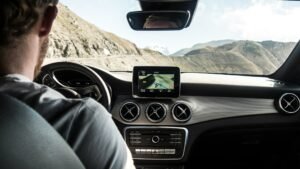
The Final Stretch: Preparing for Your G2 Road Test in Ontario
Preparing for your G2 road test in Ontario is a significant step towards gaining greater
The weather in Canada can be fickle, especially in the winter, and it may throw you off when you’re on the road. Even if you’ve done your bit by fitting good winter tyres and driving extra cautiously throughout the winter months, a snow-covered street might have its mind. When you’re out on the road, anything may happen, especially if the weather is terrible. That is why we feel you should always have a few car essentials in your boot. After all, it’s better to be safe than sorry. If you get trapped, the difference between a safe but inconvenient delay and a hazardous, life-threatening wait might be the difference in life and death.
To learn what is essential to keep in winter car pack and drive safely in winter; many driving schools like “Good Drivers“ have designed winter driving courses. The Good Drivers, a Car driving school Brampton never confuses confidence with competence. Our driving school was established to prepare safe drivers who are capable enough to protect them on the road without the actions of others. Our well-trained and experienced instructors mainly focus on winter driving skills. They also guide you on how to prepare your car for stormy weather conditions. Our Driving lessons Brampton will give you all the skills needed to deal with changing road conditions in ice and snow. Here, we will guide you about winter car packs. Hopefully, as we start unpacking ours, you’ll understand the benefits of having an auto emergency kit even more clearly. You should get your kit when you need it the most, so keeping it near the front door is a good option. Of course, we’d recommend keeping it on hand at all times, but you could also pack it anytime you suspect some dreadful winter weather is on the way. In any case, make sure you have it on hand in case the worst happens. So, without further ado, here’s everything you should have in your winter pack for your automobile. For extra peace of mind, it also explains why you should carry each item and its function in keeping you safe in an emergency.
De-icer and ice scraper: Your windscreen may have completely frosted over if the weather has turned bad while you’ve been away from home. You can’t drive your car like this, and while heating water from a kettle could help, it won’t always work. What happens if you get halfway home before the weather becomes too terrible to continue and you have to park your car overnight? On the other hand, an ice scraper is a quick and effective technique to clear your windows. Invest in a de-icer solution if you want to expedite the procedure. This breaks the connection between the ice and your windscreen by decreasing the freezing point of water. It can also be combined with a salt (later on) to remove ice from roadways and increase traction. When scraping your windscreen, always wear gloves – you don’t want to start driving with numb hands, do you?
Bulbs on hand: Even if you’re not sure how to change a headlight bulb, it’s still a good idea to have them on hand. Headlight failure may be hazardous when driving in the rain, fog, or snow. You’ll have trouble seeing other drivers, and they’ll have difficulty seeing you. So keep a few spare bulbs in your car just in case something goes wrong, and if you can, understand how to change the bulb yourself. It will save you a little money as well as a lot of time and effort.
A shovel: A shovel can rescue the day if you are stranded in a snowdrift or mud puddle. You may dig away from around a spinning tyre, or you can add new snow or mud to the mix to increase the tire’s grip. You don’t want to drag about a full-sized shovel, so search for one that folds up small enough to fit in your trunk. During the winter, several grocery stores and hardware stores offer tiny snow shovels just for this purpose!
Hazard triangles or LED flashers: Hazard triangles or LED flashers can give approaching cars a “heads up” while also marking your location if your car slips off the road or gets into a fender collision. These visible warning signs offer motorists more time to lower their speed and avoid hitting your car in less-than-clear conditions while also assisting emergency personnel in locating your location.
A sleeping bag and blanket in your car: It’s never nice to be stranded in a car for hours, but it’s worse when it’s frigid. Keep a sleeping bag instead of sitting in your car with the heating on and wasting gasoline. If you’re stranded out in the snow, it’s critical to keep your body warm. The colder you get, the riskier it becomes since hypothermia might set in. To insulate oneself as much as possible, it’s better to carry both.
Multiple warm clothes: You can always be warmer inside your sleeping bag or under your blanket, no matter how warm you are. If you can wear four or five extra layers, you can keep your body heat trapped for longer, especially if you’re detained for a lengthy time. Because less heat can escape, many layers of clothing are far more efficient than a heavy coat. Instead, it gets trapped between each layer of clothes, providing more protection from the cold. You can remove one of the layers of clothes easily if you feel too hot. It’s always preferable to be too hot than too cold, especially if you’re shivering and don’t have any extra clothing to put on.
So there you have it! This winter, keep yourself safe and your car moving with this car emergency pack. Make sure you pack yours ahead of time and keep it packed with everything on this list.
Drive safe!

Preparing for your G2 road test in Ontario is a significant step towards gaining greater

Getting your driver’s license is a milestone many of us dream about. Symbolizing freedom and

In the fast-paced environment of today’s roads, transitioning from a reactive to a proactive driving

Passing your G2 road test is a significant milestone in becoming a licensed driver. It

Driving in Canada will be considerably different for many new immigrants from driving in their

Good Drivers was established in 1981, with the aim of providing affordable driver education programs of excellent quality for all members of our society.
10095 Bramalea Rd, Unit #201, Brampton, ON, L6R 0K1